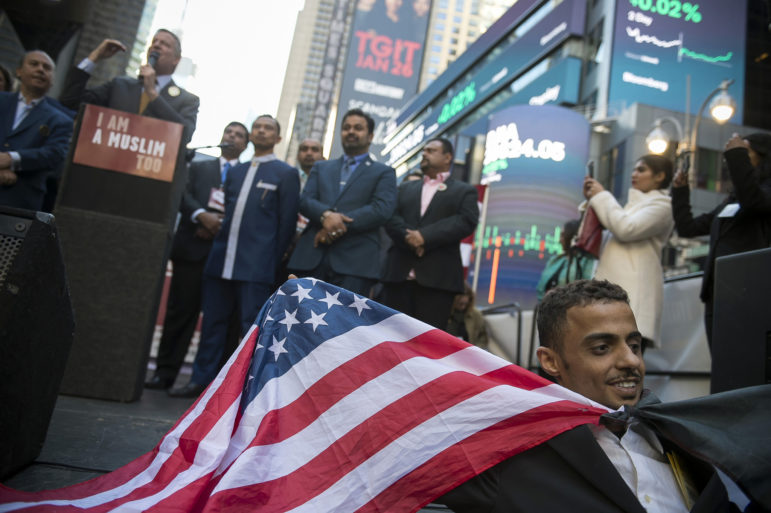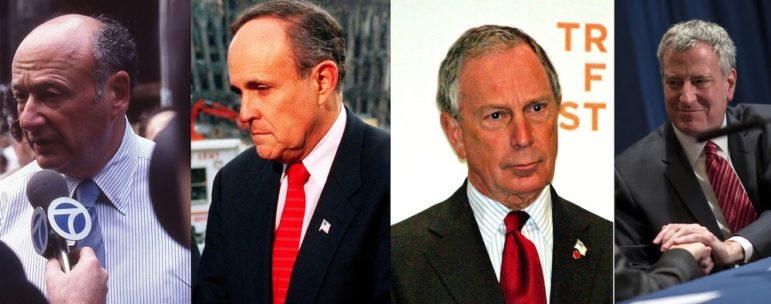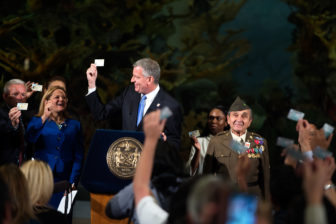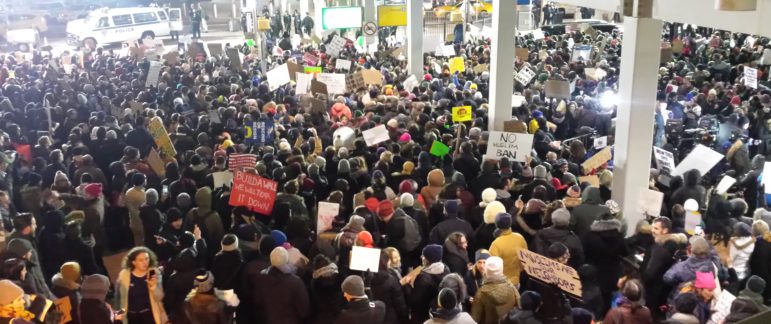
Ed Reed/Mayoral Photography Office
City Limits has teamed up with The Nation to examine Mayor Bill de Blasio’s impact on the city and the issues that should drive the debate during the 2017 municipal campaign.
Read other stories in the series.
* * * *
Ninaj Raoul didn’t have much time to talk when I called her on February 14. The executive director of Haitian Women for Haitian Refugees was busy phoning all the organization’s pregnant clients to warn them to skip their appointments at a medical center in Brooklyn until further notice. Raoul had received word earlier in the day from a contact at the hospital that Immigration and Customs Enforcement (ICE) agents were on site. “There are people who are not coming out of the examining rooms,” the contact had told Raoul.
The next day, a spokeswoman for Kings County said there was no truth to the report. Nonetheless, Raoul had done the responsible thing in a city of immigrants faced with a hostile federal government: tell people to be as careful as they can until safety is certain.
There’s not much certainty for New York’s undocumented these days. A City Council member had called Raoul earlier in the week to report word of raids in East Flatbush, a Brooklyn neighborhood that is home to many Haitian immigrants. There were rumors—just rumors—of immigration-enforcement traffic stops. There had been word the week before about agents setting up shop at Lehman College, a Bronx outpost of the City University of New York. On social media, some pleaded for caution in spreading the reports and rumors, but the alerts kept coming, sharpened by the reality that ICE had arrested nearly 40 New Yorkers the previous weekend.
“I can just say that there’s a lot of panic right now amongst the people that are living in the city, immigrants in particular,” Raoul said. “People are afraid—afraid to go out.”
Like other progressive mayors around the country, New York City’s Bill de Blasio has positioned himself as a leader of the Democratic resistance to Donald Trump, with immigration policy a key part of the rallying cry. The day after the election, de Blasio declared, “We stand behind Lady Liberty with open arms to welcome immigrants and refugees. We always have and we always will.” And immigration was one of the topics de Blasio says he raised with Trump when they met at Trump Tower in mid-November.
De Blasio is not a newcomer to the immigration issue. One of his proudest accomplishments is the creation of IDNYC, an official photo ID for people who might otherwise not be eligible for most forms of identification, especially immigrants. During his first year in office he rolled back the city’s cooperation with ICE, and under his authority the city has begun funding legal representation for people in immigration detention, providing immigration-law consultations to defense lawyers in criminal cases, offering help to those wishing to become citizens, and providing assistance to New Yorkers who wanted to take advantage of President Obama’s Deferred Action for Childhood Arrivals, which allows immigrants who arrived as children to normalize their status for a number of years.
Now the challenges the undocumented face are starker, and de Blasio’s language reflects the higher stakes. “We will not deport law-abiding New Yorkers. We will not tear families apart,” the mayor said after President Trump issued his January 25 executive order authorizing a crackdown on “sanctuary cities.” After the Ninth Circuit ruling in which a three-judge panel ruled to maintain a stay on Donald Trump’s anti-immigrant travel ban, de Blasio declared, “Here in New York—the safest big city in America—we will always protect our neighbors, no matter where they came from or when they got here.” De Blasio didn’t mention “immigrant” or “immigration” in his February 13 State of the City speech, but he made obvious reference to the rising sense of alarm among the undocumented. “There’s a lot of people in the city right now who fear for what’s happening….,” he told the crowd. “I want to say clearly to all of them, New York City will have your back.”
Under de Blasio and earlier mayors, New York has made real progress at creating a safer space for undocumented people. Yet the reality is that the city is limited in what it can do to resist Trump’s anti-immigrant push, because federal enforcement agencies have the right, and the power, to seize people in the city virtually wherever and whenever they want, whether the mayor likes it or not. And if the city wants to do more than it’s already doing, the mayor will have to confront the thorny issues of crime and punishment on which he has walked a tightrope for 38 months.
In the minds of many on the right, New York City has long been a poster child for sanctuary cities, what with neighborhoods like Chinatown, Corona, Woodlawn, Bay Ridge, and Brighton Beach, where an “American” accent is hard to find. But to Muzaffar Chishti, director of the Migration Policy Institute’s office at New York University School of Law, it’s only recently that the city really embraced the role. “For a long time, despite its reputation as a ‘sanctuary city,’ New York was still quite instrumental in removing people,” Chishti says. “The city has obviously gone through a kind of nuanced history and finally come to a place, it seems, where the policy and the rhetoric now match.”
Over the past 28 years, five mayors have wrestled with how to carve out of increasingly hostile federal policy a livable place for a city of immigrants. In 1989, Ed Koch issued an executive order barring city workers from asking about or sharing information about people’s immigration status. David Dinkins continued that approach. The policy was rendered illegal by the 1996 federal immigration law, so Rudy Giuliani sued to preserve it. He lost. Michael Bloomberg in 2003 set out to fill the vacuum created by the federal law. His first effort, an executive order that provided a few weak protections for immigrants while giving cops free range to police immigration offenses, outraged advocates, so the mayor signed a second order—Executive Order 41—later that year. This order set limits on the amount of information cops, along with other city workers, could seek and disclose about a person’s immigration status. De Blasio continued to enforce the order after he took over.

B. Golladay, DOD, D. Shankbone, E. Reed
Koch created a form of sanctuary in '89. Giuliani sued to protect it. Bloomberg redefined it. The principle now faces its harshest test under de Blasio.
The fact that those five mayors found common cause is telling, in light of their ideological differences. Giuliani’s place in the story, given his recent star turn as the man who helped Trump shape the first Muslim ban, is particularly ironic. Koch, like Giuliani, had deep disagreements with the city’s communities of color. Bloomberg permitted a massive New York City Police Department (NYPD) spying operation on the city’s Muslims and Arabs. But all the mayors recognized that the city of New York would face serious internal problems if the undocumented retreated to the shadows. “When the parents of an immigrant child forego vaccination for fear of being reported to the federal immigration authorities, we all lose. Tuberculosis and other contagious diseases do not discriminate based on national origin. They infect all children equally,” Bloomberg said when he signed Executive Order 41. “Likewise, we all suffer when an immigrant is afraid to tell the police that she has been the victim of a sexual assault or domestic violence. As good as they are, our police officers cannot stop a criminal when they are not aware of his crimes, which leaves him free to do it again to anyone he chooses.”
After Bloomberg signed Executive Order 41, the concern shifted from how police officers dealt with immigrants to how city agencies dealt with ICE, which under President George W. Bush and then President Obama ramped up immigration enforcement. ICE had an office out at Rikers Island, the city’s jail complex, to facilitate the efficient seizure of deportable people after they were released from jail, and both cops and correction officers honored “detainers”—requests from ICE to hold prisoners so that the ICE agents could come get them. The vast majority of those people were not felons and many hadn’t even committed a misdemeanor. After a campaign by advocates, the City Council passed and Bloomberg signed three different laws restricting cooperation between city law enforcement and ICE. De Blasio signed two more in late 2014 that required federal authorities to present a judicial warrant if they wanted someone in NYPD or Department of Correction custody detained. Further, the de Blasio laws basically limited the scope of detentions to people convicted of one of a list of 170 fairly serious crimes, like assault, rape, and kidnapping.
These changes had a huge effect on the city’s role in deporting people. In the last year before those laws took effect, the city’s jails honored 3,074 immigration detainers. Last year, the Department of Correction honored zero.
“It used to be people were just funneled from New York City jails into immigration detention, behind the scenes,” says Alisa Wellek, executive director of the Immigrant Defense Project, whose hotline has seen its call volume triple since Trump was inaugurated. “People were just disappeared.”
Cooperation from local law enforcement is not just helpful to federal immigration enforcement; it is indispensable, because the size of the undocumented population makes other strategies unwieldy. That is precisely why Trump is threatening to take a blowtorch to de Blasio’s budget, as well as those of other mayors who insist on maintaining their cities’ sanctuary status.
“Sanctuary jurisdictions across the United States willfully violate Federal law in an attempt to shield aliens from removal from the United States. These jurisdictions have caused immeasurable harm to the American people and to the very fabric of our Republic,” the president’s January 25 executive order read. It directed the Departments of Justice and Homeland Security to prevent sanctuary cities from getting federal funds “except as deemed necessary for law enforcement purposes.”
It’s scary sounding, especially to a city that depends on federal aid for about a tenth of its $82 billion budget, but Trump’s approach appears vulnerable to a legal challenge. The 10th Amendment prevents the federal government from commanding state and local governments to carry out federal policy, and recent Supreme Court decisions have limited the extent to which Washington can threaten to cut off funding to coerce localities and states into adopting a particular policy. (Several cities have already sued to block the “sanctuary cities” order, but New York appears to be waiting until the federal government actually moves to cut off its money.) The nature of the federal aid could also insulate the city from harm: While the $8.5 billion in annual aid encompasses housing and anti-poverty funding, the parts of that package most vulnerable to reduction are those that fund NYPD counter-terrorism activities. Those would seem to fall under the “law enforcement purposes” caveat; at the very least, cutting the funds that protect Wall Street and other prominent terrorist targets would seem terrible politics, even by Trump’s standards.

Demetrius Freeman/Mayoral Photography Office
Mayor de Blasio, with Speaker Melissa Mark-Viverito at his side, at a promotional event for IDNYC in 2015.
There are, however, other threats—and almost all of them lie at the troubled intersection of policing policy and immigrants’ rights. First there’s the mayor’s lauded IDNYC initiative. Unlike other cities that launched a municipal ID program, New York’s ID law required the retention of personal documents, like passports and other papers that could be used to discover whether the applicant was not a legal resident. This was done at the insistence of then–NYPD Commissioner Bill Bratton, citing a need to track down criminals who obtain the ID through fraud. At the time the ID program was being considered, the New York Civil Liberties Union (NYCLU) warned, “the city is inviting New Yorkers to gamble with the stakes as high as prosecution or even deportation.”
The IDNYC law was supposed to allow the city to destroy those documents in late 2016, to prevent a new president from swooping in to snatch them and let ICE track down those applicants who supplied foreign passports or other non-US paperwork. But two Republican State Assembly members from Staten Island, Nicole Malliotakis and Ron Castorina Jr., have gone to court to block the city from following through on that step. A decision on whether the city can shred those papers, or would have to preserve them for possible seizure by the federal government, is expected by May.
Then there’s that list of 170 crimes that were exempted from the 2014 ban on ICE detainers—offenses like rape, murder, kidnapping, and gang assault. Under questioning last month by one of those Republican politicians, de Blasio said that he’d be willing to expand that list of crimes. “If there are some offenses that we should add, we are willing to do that always,” he told a state Assembly committee. De Blasio has not expanded on or repeated that statement, but it outraged criminal-justice advocates who, if anything, want the mayor to shrink the list, so fewer suspects get reported to ICE.
Those advocates have long been after de Blasio to roll back the NYPD’s “broken-windows” policing, which targets relatively low-level crimes for aggressive enforcement. While de Blasio’s NYPD has arrested far fewer people, the numbers are still high, and starkly skewed toward black and brown people. City Hall has defended its approach as necessary to keep overall crime at record lows.
Trump’s more aggressive immigration enforcement deepens the problems with broken-windows policing. Every arrest in New York City, whether for felony (like assault or rape) or misdemeanor (like jumping a subway turnstile or loitering*), results in a report of fingerprints from the NYPD to the state’s Division of Criminal Justice Services (DCJS), and from DCJS to the FBI, which shares them with the Department of Homeland Security (DHS), of which ICE is part. This has the effect of alerting federal authorities to the location of any undocumented person who was previously fingerprinted. And when there are no prior fingerprints on record, federal authorities could ask the NYPD for the place of birth associated with a particular name and prints. The exact interplay between the feds and One Police Plaza is murky, says Wellek. “It’s a little bit of a black box.” The NYPD does generate more summonses than it does arrests (1 million for moving violations and another 323,000 for “quality of life” crimes in fiscal 2016), and summonses do not involve fingerprinting. But the NYPD does still produce about 180,000 misdemeanor arrests a year—20 percent more than the rest of New York State combined.
The DHS memos leaked on February 18 indicate the Trump administration plans to target “virtually any undocumented immigrant in the US if they are even suspected of a crime,” according to CNN. If the mayor is serious about doing more to reduce the risks of deportation for undocumented people, a reconsideration of how the NYPD polices misdemeanors—with all the political risks that entails—will be unavoidable.
“The mere fact of an arrest,” says Jordan Wells, a staff attorney at the NYCLU, “turns someone into a target for the Trump deportation force when they otherwise wouldn’t have been.”
There are some efforts in the city, by Council Speaker Melissa Mark-Viverito and some of the district attorneys, to reduce the impact of low-level arrests by diverting people to alternative programs before they are busted or vacating old warrants. There are few signs, however, that a broader rethink is underway. A few weeks back, I asked the head of de Blasio’s Office of Immigration Affairs, Nisha Agarwal, if she had recommended any changes to broken-windows policing because of the deepening immigration consequences. “I think that is probably not a question for me,” she said. “I leave it to [NYPD] Commissioner [James] O’Neill.”

Jarrett Murphy
Terminal 4, John F. Kennedy Airport, January 28, 2017. The rapid rise of a local protest movement is one difference between the current escalation of xenophobic rhetoric and the one after the September 11 attacks.
The fear and suspicion of 2017 feels unprecedented. But Sayu Bhojwani, who served from 2002 to 2004 as the city’s first commissioner of immigrant affairs, recalls the days of the Bush administration’s Special Registration program, which required people from mostly Muslim-majority countries to undergo fingerprinting and interviews at immigration offices, and the brutal post–September 11 detentions of innocent migrants at the Metropolitan Detention Center in Brooklyn. “There are a lot of parallels to that time, but a striking difference is the sort of public mood,” she says. “It was a different moment. I mean, it was just months after 9/11. So everybody was totally irrational. There were well-meaning people in the government who had no idea how afraid immigrant communities were. People didn’t know. This was all new.” This time around, thousands of New Yorkers raced to the airport to protest the first Muslim ban. It indicates a heightened awareness of the threat of silence.
At a march for immigrant rights in the Bronx on a cold and rainy Sunday in February, Fatomata Fatoure shouted “We have rights! We pay taxes! We have children!” at the top of her lungs as she cruised down the slushy sidewalk in her headscarf and hijab. She’s been in the city for 17 years, works for the city hospital system, and has children who are citizens. I asked her if she felt New York was a sanctuary. “Used to be. Not now. We are not safe at all. We are in the city of fear.” Did she trust de Blasio to protect her? “We ask him to be protected. That’s what we ask him.”
De Blasio might not be able to answer that call. “De Blasio cannot stop ICE agents with valid warrants from arresting people. There’s nothing the city government can do,” notes Chishti, of the Migration Policy Institute. “It’s not that the mayor can hide people under his desk.” Given those limitations, “It’s a little disingenuous to be talking about the ‘sanctuary city,'” says Bhojwani
Over in the mayor’s Office of Immigration Affairs, Agarwal is conscious of the danger that the noble rhetoric about defending immigrants could give a false impression of the city’s powers to do so. “ICE does have the ability to arrest people in public. People should know there are limits to what the city can do,” she says. “We’re very clear about what we can do and what we can’t do. People should know what their rights are, and that doesn’t mean the city can always intervene but you should always be able to have access to information.” That’s why, she says, her office has helped to coordinate some 150 Know Your Rights trainings since the election.
The city is also taking a behind-the-scenes role in knocking down some of the false reports of enforcement activity, working with groups like the Immigrant Defense Project, which debriefs defense lawyers and detainees to find out how people are getting picked up. One issue that’s arisen, according to Wellek: ICE officers sometimes pretend to be NYPD, seeding communities with fear and confusion.
“The more we can say, ‘These stories are not conformed, not verified,’ is important,” Agarwal says. “The number of rumors that we’re hearing about, working with our community partners, has subsided a little bit. The level of fear and concern is alive and well and will be for some time.”
Clarification: While first-degree loitering (which involves loitering “for the purpose of unlawfully using or possessing a controlled substance,” according to the penal code) and loitering for the purposes of prostitution are misdemeanors and require fingerprints to be taken, strict “loitering” is a noncriminal violation and does not.
This article was originally published by








